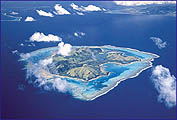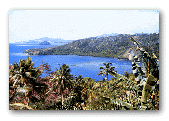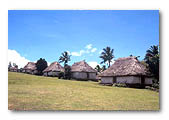| |
About Fiji
History
According to Fijian legend, the great chief Lutunasobasoba
led his people across the seas to the new land of Fiji. Most
authorities agree that people came into the Pacific from Southeast
Asia via the Malay Peninsula. Here the Melanesians and the
Polynesians mixed to create a highly developed society long
before the arrival of the Europeans.
The European discoveries of the Fiji group were accidental.
The first of these discoveries was made in 1643 by the Dutch
explorer, Abel Tasman and English navigators, including Captain
James Cook who sailed through in 1774, and made further explorations
in the 18th century.
Major credit for the discovery and recording of the islands
went to Captain William Bligh who sailed through Fiji after
the mutiny on the Bounty in 1789.
The first Europeans to land and live among the Fijians were
shipwrecked sailors and runaway convicts from the Australian
penal settlements. Sandalwood traders and missionaries came
by the mid 19th century.
Cannibalism practiced in Fiji at that time quickly disappeared
as missionaries gained influence. When Ratu Seru Cakobau accepted
Christianity in 1854, the rest of the country soon followed
and tribal warfare came to an end.
From 1879 to 1916 Indians came as indentured labourers to
work on the sugar plantations. After the indentured system
was abolished, many stayed on as independent farmers and businessmen.
Today they comprise 43.6 per cent of the population.
Culture
Fiji was first settled about three and a half thousand years
ago. The original inhabitants are now called "Lapita
people" after a distinctive type of fine pottery they
produced, remnants of which have been found in practically
all the islands of the Pacific, east of New Guinea, though
not in eastern Polynesia. Linguistic evidence suggests that
they came from northern or central Vanuatu, or possibly the
eastern Solomons.
Before long they had moved further on, colonizing Rotuma to
the north, and Tonga and Samoa to the east. From there, vast
distances were crossed to complete the settlement of the Pacific
to Hawaii in the north, Rapanui (Easter Island) in the east
and Aotearoa (New Zealand) in the south.
Unlike the islands of Polynesia which showed a continuous
steadily evolving culture from initial occupation, Fiji appears
to have undergone at least two periods of rapid culture change
in prehistoric times.
This may have been due to the arrival of fresh waves of immigrants,
presumably from the west. Prehistorians have noted that a
massive 12th century volcanic eruption in southern Vanuatu
coincides with the disappearance there of a certain pottery
style, and its sudden emergence in Fiji.
It is hardly surprising then, that the Fijian culture is an
intricate network and that generalisations are fraught with
danger. Although the legendary king of Bau, Naulivou, and
his successors had control over a large area of eastern Fiji,
at no time before colonialisation was Fiji a political unity.
Nevertheless, Fiji does exhibit certain traits that sets it
apart from its neighbours, and it is this that defines a distinctive
Fijian culture.
Europeans
Fijians first impressed themselves on European consciousness
through the writings of the members of the expeditions of
Cook who met them in Tonga. They were described as formidable
warriors and ferocious cannibals, builders of the finest vessels
in the Pacific, but not great sailors.
They inspired awe among the Tongans, and all their manufactures,
especially bark-cloth and clubs, were highly esteemed and
much in demand. They called their home Viti, but the Tongans
called it Fisi, and it is by this foreign pronunciation, Fiji,
first promulgated by Cook, that these islands are now known.
After the explorers, other Europeans followed. For over half
a century, Fijian culture enjoyed what has been called its
‘golden age’, as tools and weapons brought by traders
were turned by resourceful chiefs to their own advantage.
Canoes and houses were built, confederations formed and wars
fought on a grand scale without precedent. Gradually and inevitably,
however, the Fijian way of life was changing. As Christianity
spread in the islands, wars ceased abruptly and western clothing
was adopted.
After Fiji was ceded to Great Britain in 1874, epidemics nearly
wiped out the population and it seemed as if the natives were
doomed. But the colonial government took the Fijians side.
Land sales were forbidden, health campaigns implemented and
the population picked up again. Theirs was not, of course,
the culture of the heathen ‘golden age’, but one
modified by the new religion and increasingly the new economic
order. Yet in today’s Fiji, independent since 1970, a
surprising amount has survived.
20th Century
The 20th century brought about important economic changes
in Fiji as well as the maturation of its political system.
Fiji developed a major sugar industry and established productive
copra milling, tourism and secondary industries.
As the country now diversifies into small-scale industries,
the economy is strengthened and revenues provide for expanded
public works, infrastructure, health, medical services and
education.
The country’s central position in the region has been
strengthened by recent developments in sea and air communications
and transport. Today, Fiji plays a major role in regional
affairs and is recognized as the focal point of the South
Pacific.
Fiji is now home to many other races — Indians, Part
Europeans, Chinese and other Pacific islanders living in harmony,
and keeping their own cultures and identity. Fijians, slightly
over 50 per cent of the total population, are essentially
members of communities. They live in villages and do things
on a communal basis.
The Indians have also regarded Fiji as their home. Most of
them are descendants of labourers brought to the country from
India to work in the sugar plantations about 100 years ago
under the indentured labour system.
Although they were offered passages back in to India after
their term, most preferred to stay. And through the years
they have continued to work the land, becoming prominent in
agriculture and also commerce. There has been some intermarriage,
but this has been minimal.
However, Indians living in the rural areas have adapted well,
some even speaking the local dialect and mixing well with
the Fijians. As a country, Fiji is rural based with about
60 per cent of the population living in the rural areas.
Religion
A multi-racial, multi-cultural nation, Fiji is represented
by all the major religions of the world. This is quickly obvious
to the visitor who will see Christian churches, Mosques, Sikh
and Hindu temples in towns and the countryside. More than
half of Fiji’s population are Christians (52.9%), Hindus
(38.1%), Muslim (7.8%), Sikhs (0.7%), Others (0.5%).
Race Relations
Race relations in Fiji are generally harmonious. The Compact
provision in the Constitution requires that full account are
to be taken of the interests of all communities. It is unlawful
to discriminate on the grounds of colour, race or ethnic origins
and it is an offence to incite racial disharmony.
Language
English is the lingua franca, but Fijian and Hindi are also
taught in schools as part of the school curriculum. Indigenous
Fijians have their own dialects and you can tell where one
comes from, from their dialect. Indians too have their own,
and generally speak a distinctive Fiji-Hindi dialect. This
is not the same as the one spoken in India.
|
|

                 

|


